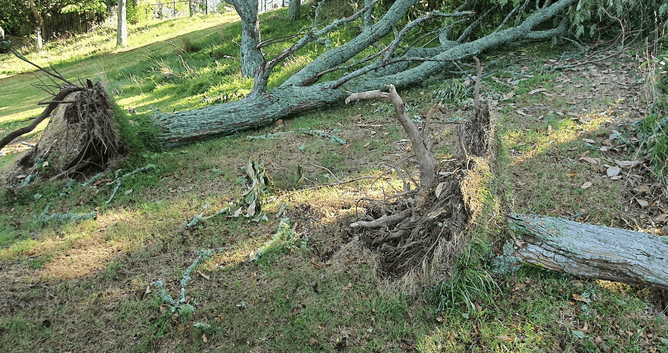Unexpected high winds and rain can only mean one thing in New Zealand; the results can be severe and hazardous to our environment.
In fact, storms can severely jeopardise a tree’s health. We have seen the impact of storm damage all over the Waikato region. From falling trees to broken limbs, these are only some of the harmful results of mother nature.
Prevention is key. It starts from planting a tree to maintaining it as it grows.
Before Planting A Tree, Do Some Homework
Being prepared for the storm season starts from day one when you plant a tree. Although, this might change if you move to a new house or commercial property and the land already has mature trees.
Nevertheless, learning more about a tree’s life and structure is beneficial to all property owners.
If you are thinking about purchasing new trees to revitalise your space, consider the following factors to prevent storm damage in the long term.
1. Choose the right tree for your property
To better understand what tree to plant around your property, we recommend visiting your local nursery or contacting an arborist to learn more about your land.
2. Think about your soil
The soil type on your property will impact how a tree will grow. For example, smaller trees will grow sufficiently in shallow soils. Do some research before heading to our local nursery or ask for advice.
3. How high will the tree grow?
Many factors, such as a tree’s height, form, root system, etc., will affect a tree’s ability to cope with high winds. The most common one to think about is the height since a tall tree will be more vulnerable to damage.
Many homeowners want trees to grow fast to create privacy from the neighbours or enhance their outdoor space. However, fast-growing trees don’t have enough time to develop a strong root foundation and crown, unlike shorter, slower-growing species.
Actions To Take Before The Storm Season
These are the steps to take before the storm seasons for those who already have mature trees.
1. Inspect
Inspect your trees regularly to check for any signs of infection, diseases or poor health. Peeling bark, chips or cracks in the trunk, dead branches, holes, leafless twigs, etc., are indications of a weakened tree. We recommend contacting our team to inspect your trees thoroughly and give you peace of mind.
2. Prune
Pruning is necessary to remove any dead, weak or diseased branches. Your property and family will be protected once the pruning is completed by our team of arborists.
Pruning also increases the light and air circulation through the canopy, resulting in a much healthier tree.
3. Support
Sometimes, people would find removing a tree easier than saving it. Although, there are different ways to save a tree, like using a cobra bracing system.
This system stabilises trees and makes them safe. However, some trees can grow so much that sometimes they can't hold their weight. This phenomenon is common with trees with multiple trunks or a large canopy.
We use the cobra bracing system to reduce the chances of failure in a healthy but weak structured tree, extend the life of a damaged tree, and reduce the potential hazards a healthy tree could have on your property and family.
4. Maintenance
Watering, mulching and fertilising are essential for a tree’s health.
5. Treatment (Pest & Diseases)
Contact our team for a free consultation to help assess a tree’s health if you notice any signs of pests or diseases.
We hope that our tips on preparing for future winter storms were helpful.
Contact us for more information or advice.



